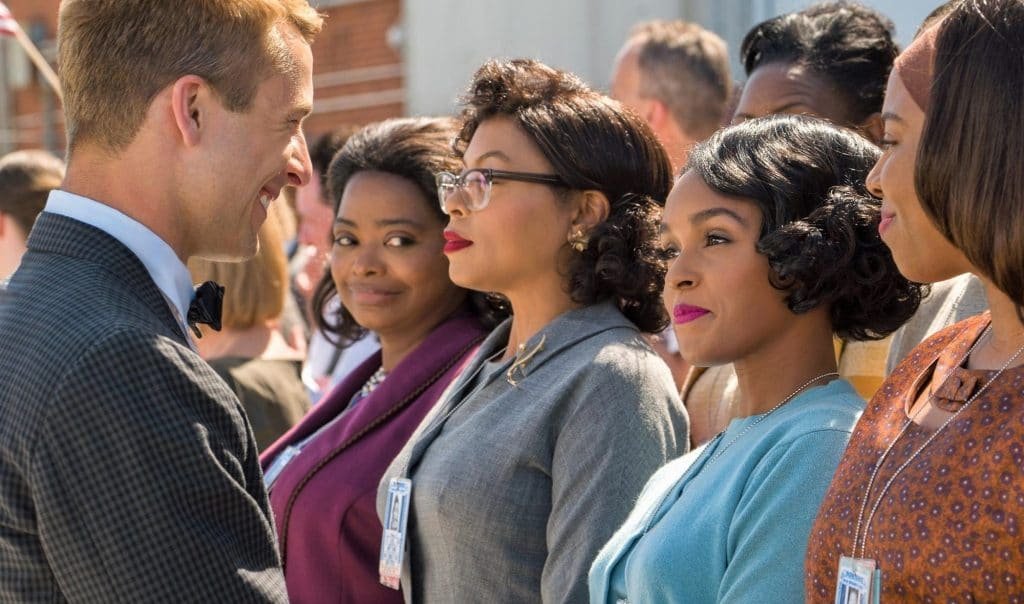In times when an escapist musical such as La La Land is being widely lauded as the film “we all need right now,” Hidden Figures is essential viewing
Hidden Figures (2016)
Directed by Theodore Melfi. Written by Theodore Melfi and Allison Schroeder, based on “Hidden Figures: The Story of the African-American Women Who Helped Win the Space Race” by Margot Lee Shetterly. Starring Taraji P. Henson, Octavia Spencer, Janelle Monáe, Kevin Costner, Kirsten Dunst, Jim Parsons, Glen Powell, Mahershala Ali and Aldis Hodge.
One of the most annoying things we commonly see in Hollywood biopics is how they tend to follow a cheap, unimaginative formula and generally cater to the most basic, undemanding desires of a mainstream audience. It was not long ago that we saw the public fall for mediocre movies like The Theory of Everything (2014), The Imitation Game (2014) and even The Danish Girl (2015), all of which seemed exclusively conceived to win as many awards as possible but showed very little artistic quality apart from their sumptuous production and acclaimed performances. Hidden Figures does something remarkably different, though, avoiding the typical clichés and any of that patronizing crap that plagues most films made by white men about African-Americans, such as The Blind Side (2009) and The Help (2011).
Adapted from Margot Lee Shetterly’s non-fiction book Hidden Figures: The Story of the African-American Women Who Helped Win the Space Race, the film recounts the story of Katherine G. Johnson (Taraji P. Henson), Dorothy Vaughan (Octavia Spencer) and Mary Jackson (Janelle Monáe), three brilliant African-American women who worked as “computers” in the segregated West Area Computers division of NASA and would play in 1961 a decisive role in the US space program. While Mary is portrayed as a black woman who dreams of becoming an engineer and Dorothy (who is the active supervisor of the division) is struggling to be officially promoted, Katherine is assigned as the very first “colored” woman in the Space Task Group to assist with the calculations for the launch of astronaut John Glenn into orbit.
Depicting without sentimentality the racial and gender obstacles that these women encounter on a regular basis in their lives, Hidden Figures understands the hardship of being a “Negro woman” in the 1960s. We see in the beginning of the film a policeman who treats them in a racist (and sexist) way only until he finds out they work for NASA — and his sudden change in conduct is just as symptomatic as their joke about being three Negro women chasing a white police officer down a highway after he offers to escort them to the agency. Likewise, it is easy to understand Dorothy’s frustration every time her request to be made official supervisor is denied, or why Mary would be so skeptical about her own chances of becoming an engineer, acknowledging the fact that if she were a white male, she would already be one.
Having to constantly prove themselves with such a huge responsibility in their hands but no career prospects ahead of them, these women are seen by their white colleagues almost as a sideshow attraction. Their segregation is especially emphasized by the striking contrast between the colorful West Area Computers and the rigorous-looking Space Task Group. While the former is shown as cozier and more joyful in its rather cramped space, with a warmer palette and the black women wearing intense colors, the latter looks wider and spartan with its washed-out colors and all of the (white) men wearing plain white shirts. After Katherine joins the Group, the vibrant colors she wears stand out amid those men, and the way they look at her (which made me think of a zoo) helps increase our discomfort for her situation.
The beautiful color scheme also illustrates each character’s personality and the relationship between them. At one moment, Katherine and her boyfriend Jim Johnson (Mahershala Ali) wear different shades of green that elegantly show us that they are on the same wavelength. And Kirsten Dunst’s character Vivian Mitchell, who is always subtly hostile towards Dorothy (a clear example of aversive racism), wears darker clothes up until the end when she finally steps down her hostility and appears in light colors. In this scene, by the way, notice how Vivian and Dorothy are framed at a certain distance from each other. The space that separates them tells us a lot about the world of difference between the two women, which is visually reinforced by a world map that can be seen between them on the wall in the back.
Using the gracious dynamics between the three women as a narrative anchor amid the whole discrimination they face every day, Hidden Figures benefits from stellar performances. The star is definitely Taraji P. Henson, who even shines in a wonderful scene when Katherine explodes after having to endure so much humiliation on a daily basis. It makes me wonder why Henson didn’t receive an Oscar nomination. And while Janelle Monáe composes Mary as an obviously intelligent and vivacious woman who gets some of the most hilarious lines in the film, Octavia Spencer is perfect as a natural leader who immediately realizes what is wrong with an IBM machine that doesn’t work — and her careful composition is miles above the caricature she played in The Help (which unfairly won her an Oscar).
It is true that the movie has a few irritating clichés (like Katherine admitting to Johnson that she almost forgot how to kiss a man), but they are compensated by subtler moments — and I love how Katherine’s boss Al Harrison (Kevin Costner) says “good work, gentlemen” to his team, unknowingly disregarding the fact that there is a woman now among them. And unlike The Imitation Game, one of the best qualities in Hidden Figures is that it cares to show us the mathematical calculations and technical details of the work performed at NASA instead of just insulting our intelligence and taking for granted our engagement with a subject that not everyone understands. But let me make it clear, I’m not defending technobabble, just that at least some explanation about the characters’ work is important.
Smart and touching, Hidden Figures is a necessary film that recognizes the indispensable work that these women did at the backstage of a world ruled by white men. And in a year when an escapist, formulaic musical like La La Land is being widely lauded by many as the movie “we all need right now,” I say think again. What we need right now is more films like this one here.





